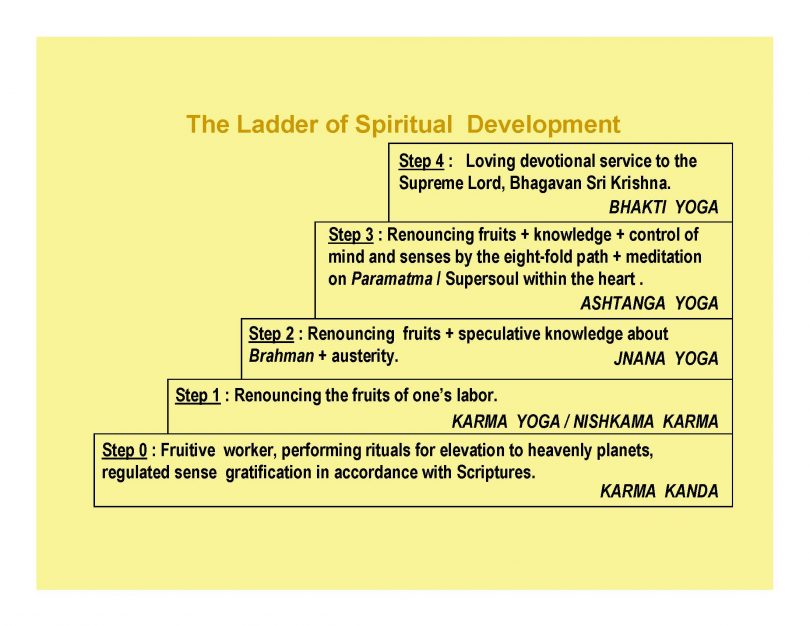Question: I have heard reference to a “Yoga Ladder” which is taught within Bhagavad-Gita and other of the Vedic literature. Can you explain this concept?
Answer by Romapada Swami:
Here is a picture of the Yoga Ladder: Yoga Ladder Picture
If you would like a more detailed description, please download this file: Detailed Description of Yoga Ladder (PDF file)
Summary description of yoga ladder
The word “Yoga” means to link – linking of our consciousness with the Supreme Absolute Truth. There are different types of yoga systems described which are named differently according to the particular method adopted. When the linking process is predominantly in fruitive activities it is called karma-yoga, when it is empirical it is called Jnana Yoga when it is predominantly in a devotional relationship with the Supreme Lord it is called Bhakti-Yoga, which is the ultimate perfection of all yogas (B.G. 6.46)
The material world is meant for the gradual purification of the conditioned souls, through the process of sacrifice. By this process, the conditioned souls can re-awaken their spiritual consciousness, which they have forgotten. The Yoga Ladder is the Supreme Lord’s system for facilitating this.
1. KARMA- KANDA: (No spiritual objective).
This is the first step in the elevation of a conditioned spirit soul. By encouraging regulated sense gratification, it brings animalistic people to a platform of religiosity. Karma-kanda purifies the practitioner in many ways.
A. It makes him practice some regulations, which brings detachment. Detachment fosters knowledge.
B. It brings him to the Vedas, which also contain Jnana (knowledge) and Upasana (worship) sections.
C. By practicing yajnas (sacrifice) and getting results, it gives him faith in sastra (scriptures).
D. It makes him associate with Brahmanas (those who are engaged in the cultivation of spiritual knowledge) who can give him knowledge.
E. After bringing one to the Vedic path and giving one faith, it will naturally lead him to examine the Jnana (knowledge) sections and Upasana (worship) sections, because the sense gratification of karma-kanda inevitably leads to frustration.
2. KARMA-YOGA:
The practice of karma-kanda leads one to the next step, karma-yoga. Here one is frustrated with living for sense gratification and wants to advance spiritually, but is still too attached to completely stop working for himself. Therefore, one starts karma-yoga on the sakama (with desire) stage.
3. SAKAMA-KARMA-YOGA: (Spiritual objective with material desires).
Here one will work in the world, but will still be attached to some of the fruits for himself. Out of a desire for purification, he will give up some of the fruits of his labor. The practice of sakama-karma-yoga leads one to the stage where he is completely detached to the fruits of his activities (nishkama-karma-yoga)
4. NISHKAMA-KARMA-YOGA: (Spiritual objective)
Here one has some fixedness in transcendental knowledge. Generally, one at this stage is detached from the fruit of his labor, but is still attached to the work itself.
5. ASTANGA-YOGA: (Spiritual objective)
This is a yoga system which helps one to achieve just as that obtained by nishkama-karma-yoga.
There are two stages in astanga-yoga: Yogaruruksu (the beginning stage) and Yogarudha (the advanced stage). These are further divided in to eight steps (asta means “eight”, and anga means “parts”). Of the eight steps in astanga-yoga, the first two are yama and niyama i.e., following the prohibitions and regulations. After one learns to strictly follow the rules and regulations, he begins to practice asanas, sitting postures (what people commonly call hatha-yoga). While the asanas are being mastered, one begins pranayama, breathing exercises. The breath is intimately connected with the mind. Therefore, pranayama helps to control the mind. When his mind is controlled, the aspiring yogi advances to the practice of pratyahara, withdrawing his senses from their objects. When he becomes detached, he practices first dharana, then dhyana, different intensities of meditation. Such meditation leads to the final stage, samadhi.
Different transcendentalists attain distinct kinds of samadhi. In samadhi, the mind and consciousness are fully focused on the Absolute. The jnani focuses on the Brahman (the impersonal, all pervading aspect of the supreme) the Patanjali yogi on paramatma (the localized aspect of the Supreme who is situated within the heart) and the bhakti yogi on Krishna (the Supreme Lord with all His opulences, one who has a spiritual form composed of eternity, knowledge and bliss). Srila Visvanatha Cakravarti Thakura explains that in the yogaruruksu (beginning) stage, one works in nishkama-karma-yoga while simultaneously practicing astanga-yoga. That purifies his heart. When the aspiring yogi becomes elevated in his practice to the point of yogarudha, he gives up nishkama-karma-yoga. Srila Baladeva Vidyabhusana adds that the yogarudha stage begins at dhyana (intense meditation on the Supreme Absolute Truth, Krishna).
6. JNANA-YOGA: (Spiritual objective)
Can be equated to giving up all social obligations in pursuit of spiritual advancement This is not recommended by Krishna because one must be highly qualified to fully give up work
7. BHAKTI-YOGA:
Is a quality that can permeate any of the stages that involve a spiritual objective, but generally, it is only fully entered into after the jnana stage.







